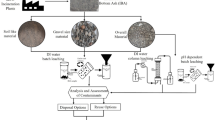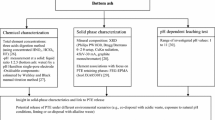Abstract
Small-scale Solid Waste Thermal Treatment (SSWTT) is prevalent in remote Chinese locations. However, the ecological threats associated with heavy metals in resultant bottom ash remain undefined. This research study scrutinized such ash from eight differing sites, assessing heavy metal content, chemical form, and leaching toxicity. Most bottom ash samples met soil contamination standards for development land (GB36600-2018). However, levels of As, Cd, Cr, Cu, Ni, Pb, and Zn in some samples exceeded agricultural land standards GB15618-2018) by 1591%, 64,478%, 1880%, 3886%, 963%, 1110%, and 2011% respectively. Additionally, the As and Cd contents surpassed the construction land control limit value by 383% and 13% respectively. The mean values of the combined oxidizable and residual fraction (F3 + F4) for each heavy metal in all samples exceeded 65%, with Cr, Cu, Ni, and Pb reaching over 95%. All sample leaching concentrations, obtained via the HJ/T 299 procedure, were less than limits set by the identification standards for hazardous wastes (GB5085.3–2007). However, only the leaching concentrations of three samples via the leaching procedure HJ/T 300 met the "Solid Waste Landfill Pollution Control Standard" (GB 16889–2008). The results indicate that the location and type of SSWTT equipment play a crucial role in determining an appropriate solution for bottom ash management.



Similar content being viewed by others
References
Administration, S. E. P. (2007b). Solid Waste Toxicity Extraction Method Sulfuric Acid and Nitric Acid Method: HJ/T 299–2007[S]. In. Beijing: China Standard Press.
Abanades, S., Flamant, G., & Gauthier, D. (2001). Modelling of heavy metal vaporisation from a mineral matrix. Journal of Hazardous Materials, 88(1), 75–94.
Administration, S. E. P. (1998). Technical Specifications on Sampling and Sample Preparation from Industry Solid Wsate : HJ/T 20–1998[S]. In. Beijing: China Standard Press.
Administration, S. E. P. (2007a). Solid Waste Toxicity Extraction - Acetic Acid Buffer Solution Method: HJ/T 300–2007[S]. In. Beijing: China Standard Press.
Administration, S. E. P. (2017). Soil and sediment - Digestion of total metal elements - Microwave assisted acid digestion method: HJ/T 832–2017[S]. In. Beijing: China Standard Press.
Association, C. N. R. R. (2021). 2020 annual report on the prevention and control of environmental pollution by solid waste in large and medium cities across the country. China Resources Comprehensive Utilization, 39(1), 1.
Chang, M. B., & Chung, Y. T. (1998). Dioxin contents in fly ashes of MSW incineration in Taiwan. Chemosphere, 36(9), 1959–1968.
Chimenos, J. M., Segarra, M., Fernández, M., & Espiell, F. (1999). Characterization of the bottom ash in municipal solid waste incinerator. Journal of Hazardous Materials, 64(3), 211–222.
Du, M., Liu, H., Hu, D., Huang, J., & Fang, Y. (2020). The leaching mechanism of heavy metals (Ni, Cd, As) in a gasification slag during acidification. Waste Management, 114, 17–24.
Gerven, T. V., Cooreman, H., Imbrechts, K., Hindrix, K., & Vandecasteele, C. (2007). Extraction of heavy metals from municipal solid waste incinerator (MSWI) bottom ash with organic solutions. Journal of Hazardous Materials, 140(1/2), 376–381.
Hakanson, L. (1980). An ecological risk index for aquatic pollution control a sedimentological approach. Water Research, 14(8), 975–1001.
Hu, Y., Chen, G., & Di, M. F. (2008). Physical and chemical characterizations of MSWI bottomash. Acta Energiae Solaris Sinica, 29(10), 1187–1191.
Huang, H., Yuan, X., Zeng, G., Zhu, H., Hui, L., Liu, Z., & Bi, W. (2011). Quantitative evaluation of heavy metals’ pollution hazards in iiquefaction residues of sewage sludge. Bioresource Technology, 102(22), 10346–10351.
Huang, L., & Huang, Y. (2016). Planning remediation and regeneration for landfill sites: European and American case studies based on the perspective of slow-motion technological disasters. Shanghai Urban Planning Review, 1, 32–40.
Huang, J., Peng, S., Mao, X., Li, F., Guo, S., Shi, L., & Zeng, G.-M. (2019). Source apportionment and spatial and quantitative ecological risk assessment of heavy metals in soils from a typical Chinese agricultural county. Process Safety and Environmental Protection, 126, 339–347.
Klein, R., Baumann, T., Kahapka, E., & Niessner, R. (2001). Temperature development in a modern municipal solid waste incineration (MSWI) bottom ash landfill with regard to sustainable waste management. Journal of Hazardous Materials, 83(3), 265–280.
Latosińska, J., & Czapik, P. (2020). The ecological risk assessment and the chemical speciation of heavy metals in ash after the incineration of municipal sewage sludge. Multidisciplinary Digital Publishing Institute, 16, 13. https://doi.org/10.3390/su12166517
Li, L. (2009). Study on the Collect and Transport System of Domestic Waste in Small Towns and Villages. Master, Huazhong University of Science and Technology.
Li, H., Zhao, C., Cai, L., Duan, L., & Chen, H. (2012). Trace elements partitioning during coal combustion in fluidized bed under O2/CO2 atmosphere. Springer Berlin Heidelberg, 355-362. https://doi.org/10.1007/978-3-642-30445-3_50
Li, Z. (2015). Investigation and analysis of comprehensive costs of collection, transportation and treatment of domestic waste in villages and towns. Construction Science and Technology, 10, 125–126.
Li, D., Chen, G.-Y., Ma, W., & Duan, N. (2018). Characteristics and treatment status of rural solid waste in China. China Environmental Science, 38(11), 4187–4197. https://doi.org/10.3969/j.issn.1000-6923.2018.11.026
Liu, J.-Y., Sun, S.-Y., Chen, T., Lu, S.-Y., Wang, Y.-J., Xie, W.-M., & Li, L. (2014). Migration behavior of Pb and its vaporization control during sewage sludge incineration process. China Environmental Science, 02(2), 466–466.
Liu, Y., Yue, L., & Li, J. (2011). Evaluation of heavy metal contamination and its potential ecological risk to the soil in Taiyuan, China. Acta Scientiae Circumstantiae, 31(6), 1285–1293.
Lu, W., Tan, F., Zhang, N., & Qin, T. (2020). Chromium content and health risk assessment of soil-vegetables in high background area of Lijiang City. Humic Acid, 3, 8.
Luo, H. (2017). Study on manganese pollution in typical regions and pollution prevention and control countermeasures——taking Tongren City, Guizhou Province as an example. Intelligent City, 2, 289–291.
Rong, Y., Gauthier, D., & Flamant, G. (2001). Partitioning of trace elements in the flue gas from coal combustion. Combustion & Flame, 125(1–2), 942–954.
Song, L., Mao, L., Yang, B., Zhu, X., & Li, X. (2015). Effect of activated carbon on leaching of chromium in chromium residue. Industrial Safety and Environmental Protection, 000(002), 26–28.
Sun, X., & Yi, Y. (2020). pH evolution during water washing of incineration bottom ash and its effect on removal of heavy metals. Waste Management, 104, 213–219.
Sun, Y., Guan, F., Yang, W., & Wang, F. (2019). Removal of Chromium from a contaminated soil using oxalic acid, citric acid, and hydrochloric acid: Dynamics, mechanisms, and concomitant removal of non-targeted metals. International Journal of Environmental Research and Public Health, 16(15), 2771.
Tay, L. C. T. V. C. J. H. (1997). The influence of pH on mobility of heavy metals from municipal solid waste incinerator fly ash. Environmental Monitoring & Assessment, 44(1), 275–284.
Towhata, I. (2008). Reuse of former landfill for urban space. Japanese Geotechnical Society, 56, 24–26.
Ure, A. M., Davidson, C. M., & Thomas, R. P. (1995). Single and sequential extraction schemes for trace metal speciation in soil and sediment. Techniques and Instrumentation in Analytical Chemistry, 17(06), 505–523.
Wang, J. (2020). Morphological characteristics and ecological risk assessment of heavy metals in municipal sludge. Shanxi Science and Technology, 35(3), 62–65.
Wang, T., Shi, X.-Y., Liu, Z.-G., Li, H.-M., & Li, P. (2014). Analysis on physical characteristics of rural solid waste in Dongjiang river source area, China. Journal of Agricultural Resources and Environment, 031(003), 285–289.
Wey, M. Y., Hwang, J. H., & Chen, J. C. (1996). The behavior of heavy metal Cr, Pb and Cd during waste incineration in fluidized bed under various chlorine additives. Journal of Chemical Engineering of Japan, 29(3), 494–500.
Wu, C., Oh, K., Long, X., & Zhang, J. (2019). Effect of installed capacity size on environmental efficiency across 528 thermal power stations in North China. Environmental Science and Pollution Research, 26(2), 29822–29833.
Xiao, G., Chen, J., Bai, B., Li, Y., & Zhu, N. (2021). Content characteristics and risk assessment of heavy metals in soil of typical high geological background areas. Yunnan Province. Geology and Exploration, 57(5), 1077–1086.
Xu, Z.-Q., Ni, S.-J., Tuo, X.-G., & Zhang, C.-J. (2008). Calculation of heavy metals’ toxicity coefficient in the evaluation of potential ecological risk index. Environmental Science & Technology, 31(2), 112–115.
Yao, J., Li, W. B., Kong, Q. N., Wu, Y. Y., He, R., & Shen, D. S. (2010). Content, mobility and transfer behavior of heavy metals in MSWI bottom ash in Zhejiang Province, China. Fuel, 89(3), 616–622.
Yi, X., He, P., Shao, L., & Hua, Z. (2017). Metal distribution characteristic of MSWI bottom ash in view of metal recovery. Journal of Environmental Sciences, 52(002), 178–189.
Yu, J.-Y., Yue, B., Zhao, D., Li, Z.-L., Wu, X.-H., Huang, Q.-F., & Jin, Q. (2018). Physic-chemical properties and seasonal variation of rural living solid waste in typical agricultural villages and towns in Central China. Environmental Engineering, 36(3), 127–132.
Zhang, G., Wang, D., Yu, Y., Wang, C., & Zhuang, J. (2016). Health risk assessment of heavy metal pollution of agricultural use of municipal solid waste incineration bottom ashes. Ecology and Environmental Sciences, 25(002), 307–313.
Zhao, M. (2014). The Investigation of Rural Life Waste Collection and Transportation Mode Evaluation of WhichiIs Based on Surveys of Hubei Province Waste Disposal. Master, Huazhong University of Science and Technology.
Zhao, L., Zhang, F. S., Wang, K., & Zhu, J. (2009). Chemical properties of heavy metals in typical hospital waste incinerator ashes in China. Waste Management, 29(3), 1114–1121.
Zhou, X.-Y., Xu, M.-G., Zhou, S.-W., & Gilles, C. (2015). Soil acidification characteristics in Southern China’s croplands under long-term fertilization. Journal of Plant Nutrition and Fertilizer, 21(6), 1615–1621.
Zhu, Y., Zhao, Y., Zhao, C., & Gupta, R. (2020). Physicochemical characterization and heavy metals leaching potential of municipal solid waste incinerated bottom ash (MSWI-BA) when utilized in road construction. Environmental Science and Pollution Research, 27(12), 14184–14197.
Acknowledgements
The authors would like to express their gratitude to EditSprings (https://www.editsprings.cn/) for the expert linguistic services provided. The study was financially supported by the National Key R&D Program of China (grant number: 2018YFD1100600).
Funding
National Key Research and Development Program of China, 2018YFD1100600.
Author information
Authors and Affiliations
Contributions
Shutong Wu,Tingting Hu,Yuyan Hu and Dezhen Chen wrote the main manuscript text and Kezhen Qian prepared figures. Dong Xue completed the sample collection.Mudassir Hussain Tahir has completed the language polishing of the article.
Corresponding author
Ethics declarations
Competing interests
The authors declare no competing interests.
Additional information
Publisher's Note
Springer Nature remains neutral with regard to jurisdictional claims in published maps and institutional affiliations.
Supplementary Information
Below is the link to the electronic supplementary material.
Rights and permissions
Springer Nature or its licensor (e.g. a society or other partner) holds exclusive rights to this article under a publishing agreement with the author(s) or other rightsholder(s); author self-archiving of the accepted manuscript version of this article is solely governed by the terms of such publishing agreement and applicable law.
About this article
Cite this article
Wu, S., Hu, T., Chen, D. et al. Ecological risk assessment of heavy metals in bottom ashes generated by small-scale thermal treatment furnaces for domestic waste in villages and towns of China. Environ Geochem Health 45, 8243–8255 (2023). https://doi.org/10.1007/s10653-023-01709-2
Received:
Accepted:
Published:
Issue Date:
DOI: https://doi.org/10.1007/s10653-023-01709-2




